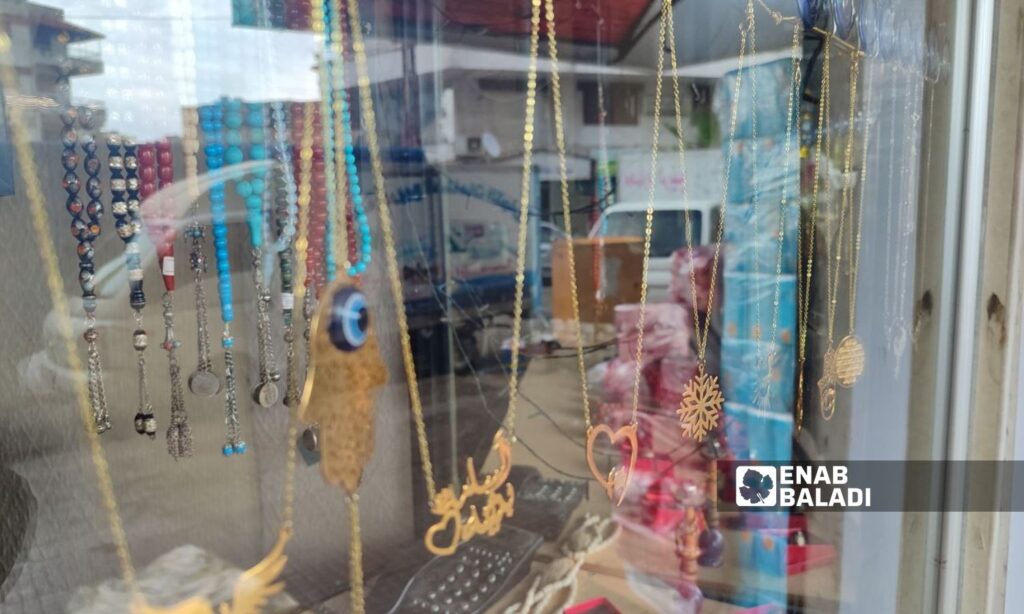Latakia – Linda Ali
Sanaa (38), a government employee in Latakia, paid about 600,000 Syrian pounds as a goldsmithing fee for a small ring weighing 3.47 grams of 21-karat gold, which she bought at the beginning of this year when the price of a gram of gold was 800,000 Syrian pounds.
She turned to buying the ring with a money transfer sent by her brother in Iraq as a New Year’s gift. Fearing to spend it all on endless household needs, she decided to purchase the small ring “for a time of need.”
What also drove her to this decision is that the value of the Syrian pound compared to the US dollar is deteriorating and may drop further at any moment. Currently, one dollar is equivalent to around 14,600 Syrian pounds.
The woman said she had sold all her gold years ago and spent the proceeds on food and family essentials, as well as on a new fridge after the old one was damaged due to the poor electricity situation in 2021 and could not be repaired again.
As of this report’s preparation, according to the official goldsmiths’ association bulletin, the price of a gram of 21-karat gold is 835,000 pounds, and a gram of 18-karat gold is 715,714 pounds, with prices changing almost daily.
According to what Enab Baladi observed, most gold sellers do not follow the official prices but price according to the black market rate with a difference exceeding 25,000 pounds. At the time of this report, the price of 21-karat gold per gram was 864,000 pounds, and for 18-karat, it was 741,000 pounds.
To avoid legal accountability, sellers resort to increasing the goldsmithing fees, ranging from 100,000 to 200,000 pounds per gram in Latakia.
Above the association’s price
In one of the jewelry stores in the gold market in downtown Latakia, a man in his fifties was trying to buy a gold lira, as they are in high demand due to their much lower smithing fees compared to crafted gold.
In vain, he negotiated with the gold seller to obtain the gold lira as the goldsmith informed him that he did not have it available. The fifty-something-year-old man explained how he had struggled in the rain searching for it to buy three gold liras as a hedge against inflation after recently selling a small piece of land he owned to cover certain expenses. With the remaining money, he wanted to buy three gold liras.
The goldsmith eventually told him that he could secure two gold liras, but at a price higher than the association’s by 225,000 pounds each, on the condition that he writes in the sales invoice that he obtained them at the association price, and the man would pay the difference without documenting it in the sales receipt.
The man agreed and bought the two liras for 14.6 million pounds, knowing that the official goldsmiths’ association bulletin priced one lira at 7.075 million pounds.
High crafting fees depending on the piece type
A goldsmith, whose shop is near the church wall in the gold market, said that goldsmithing fees vary depending on the piece, and usually, the crafting of 21-karat gold is less than that of 18-karat.
The gold seller charged 150,000 pounds in crafting fees per gram to sell a piece of gold bracelet of 18 karat weighing 3.59 grams. After much haggling, he reduced it to 145,000 pounds but then advised the customer to buy the piece that same day because its price and crafting fees would rise the next day.
Enab Baladi also noted a clear disparity in the goldsmithing fees between shops. For example, large, well-known stores request crafting fees starting from 160,000 pounds per gram, reaching about 225,000 pounds, while smaller stores charge between 100,000 and 150,000 pounds.
Some shops suggested to the report’s author, who communicated with the owners as a customer, to buy “broken gold” with smithing fees of 75,000 pounds per gram.
“Broken gold” refers to a part of a 21-karat chain, for instance, from which the goldsmith cuts off a piece that fits the amount the customer can afford and then sells it to them.
In recent years, with the deterioration of living and economic conditions, Syrians have turned to imitation gold (Brazilian and Russian) to fulfill wedding traditions, which reach a level of sanctity in the customs of Syrian society.
“Brazilian” gold is a base metal of no value, consisting of lead and tin, but it closely resembles the color and shine of real gold.
The price of an engagement ring made of “Brazilian” gold ranges between 100,000 and 300,000 Syrian pounds depending on its weight and design, and the price of some Brazilian gold sets ranges from 700,000 to one million Syrian pounds.

